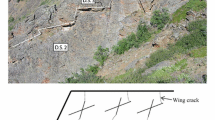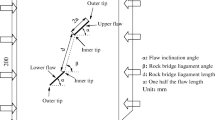Abstract
This paper uses peridynamic simulations to determine the extent of coalescing damage and identify the underlying causes. The basic crack types and crack coalescence patterns in specimens with a flaw pair under uniaxial compression are systematically investigated. Various crack types including horsetail cracks, anti-wing cracks, and tensile wing cracks are successfully observed and the coalescence sequences are identified. By varying angles, six crack coalescence categories with respect to the overlapping ratios provide insightful information of different crack growths and indicate various cracking modes underlying various coalescence patterns. The arrangement of the flaw pair strongly influences the crack initiation position and trajectories, allowing for different coalescence morphologies. Coalescence formed by two internal tensile wing cracks, or transfixion, shows unbroken crack segments with a further loading, along with growing shear cracks until failure. In contrast, after the coalescence is formed through two horsetail cracks, the interior of the rhombic shape gets deformed with further loading. The peridynamic code adopted in this research can provide realistic simulation results and help researchers to conduct expanded tests as well as to enhance understanding the fracture of rock-like material.


















Similar content being viewed by others
References
Bobaru F, Zhang G (2016) Why do cracks branch? A peridynamic investigation of dynamic brittle fracture. Int J Fract.doi:10.1007/s10704-015-0056-8
Bobet A, Einstein HH (1998) Fracture coalescence in rock-type materials under uniaxial and biaxial compression. Int J Rock Mech Min Sci 35(7):863–888
Bombolakis EG (1963) Photoelastic stress analysis of crack propagation within a compressive stress field, Ph.D. Thesis, Massachusetts Institute of Technology
Cao P, Liu T, Pu C, Lin H (2015) Crack propagation and coalescence of brittle rock-like specimens with pre-existing cracks in compression. Eng Geol 187:113–121
Crider JG, Peacock DCP (2004) Initiation of brittle faults in the upper crust: a review of field observations. J Struct Geol 26:691–707
Ercolessi F (1997) A molecular dynamics primer. Spring College in Computational Physics, ICTP, Trieste, pp 24–25
Ha YD, Bobaru F (2009) Traction boundary conditions on peridynamics: a convergence study, Technical report, Department of Engineering Mechanics, University of Nebraska-Lincoln, Lincoln, Nebraska
Ha YD, Bobaru F (2010) Studies of dynamic crack propagation and crack branching with peridynamics. Int J Fract 162:229–244
Ha YD, Bobaru F (2011) Characteristics of dynamics brittle fracture captured with peridynamics. Eng Fract Mech 78:1156–1168
Ha YD, Lee J, Hong JW (2015) Facturing patterns of rock-like materials in compression captured with peridynamics. Eng Fract Mech 144:176–193
Kilic B, Madenci E (2010) Coupling of peridynamic theory and the finite element method. J Mech Mater Struct 5(5):707–733
Ko TY, Kemeny J (2006) Crack coalescence in brittle material under cyclic loading, ARMA/USRMS 06-930
Lajtai EJ (1974) Brittle-fracture in compression. Int J Fract 10:525–536
Lee J, Liu W, Hong JW (2016) Impact fracture enhanced by contact of peridynamic and finite element formulations. Int J Impact Eng 87:108–119
Li H, Wong LNY (2012) Influence of flaw inclination angle and loading condition on crack initiation and propagation. Int J Solids Struct 49:2482–2499
Li HQ, Wong LNY (2014) Numerical study on coalescence of pre-existing flaw pairs in rock-like material. Rock Mech Rock Eng 47:2087–2105
Li YP, Chen LZ, Wang YH (2005) Experimental research on pre-cracked marble under compression. Int J Solids Struct 42:2502–2516
Liu W, Hong JW (2012a) Discretized peridynamics for linear elastic solids. Comput Mech 50(5):579–590
Liu W, Hong JW (2012b) Discretized peridynamics for brittle and ductile solids. Int J Numer Mech Eng 89:1028–1046
Liu W, Hong JW (2012c) A coupling approach of discretized peridynamics with finite element method. Comput Method Appl Mech 245–246:163–175
Manouchehrian A, Marji MF (2012) Numerical analysis of confinement effect on crack propagation mechanism from a flaw in a pre-cracked rock under compression. Acta Mech Sin 28(5):1389–1397
Manouchehrian A, Sharifzadeh M, Marji MF, Gholamnejad J (2014) A bonded particle model for analysis of the flaw orientation effect on crack propagation mechanism in brittle materials under compression. Arch Civ Mech Eng 14:40–52
Mughieda O, Alzo’ubi AK (2004) Fracture mechanics of offset rock joints: a laboratory investigation. Geotech Geol Eng 22(4):545–562
Oterkus E (2010) Peridynamic theory for modelling three-dimensional damage growth in methallic and compisute structures, Ph.D. Dissertation, University of Arizona
Park CH, Bobet A (2009) Crack coalescence in specimens with open and closed flaws: a comparison. Int J Rock Mech Min Sci 46:819–829
Park CH, Bobet A (2010) Crack initiation, propagation and coalescence from frictional flaws in uniaxial compression. Eng Fract Mech 77:2727–2748
Parks ML, Plimton SJ, Lehoucq RB, Silling SA (2008) Peridynamics with LAMMPS: a user quide. Technical report, technical report SAND 2008-1035. Sandia National Laboratories
Reyes O, Einstein HH (1991) Failure mechanisms of fractured rock: a fracture coalescence model. In: Proceedings 7th international congress of rock mechanics, vol 1, pp 333–340
Sagong M, Bobet A (2002) Coalescence of multiple flaws in a rock-model material in uniaxial compression. Int J Rock Mech Min Sci 39:229–241
Shen B, Stephansson O, Einstein HH, Ghahreman B (1995) Coalescence of fractures under shear stress experiments. J Geophys Res 100(6):5975–5990
Silling SA, Askari E (2005) A meshfree method based on the peridynamic model of solid mechanics. Comput Struct 83:1526–1535
Sillng SA (2000) Reformulation of elasticity theory for discontinuities and long-range forces. J Mech Phys Solids 48:175–209
Van Der Zee W, Urai JL (2005) Processes of normal fault evolution in a siliciclastic sequences: a case study from Miti, Sarawak, Malaysia. J Struct Geol 27(12):2281–2300
Vasarhelyi B, Bobet A (2000) Modeling of crack initiation, propagation and coalescence in uniaxial compression. Rock Mech Rock Eng 33(2):119–139
Wong LNY, Einstein HH (2009) Systematic evaluation of cracking behavior in specimens containing single flaws under uniaxial compression. Int J Rock Mech Min Sci 46:239–249
Wong NY (2008) Crack coalescence in molded gypsum and Carrara marble, Ph.D. Dissertation, Massachusetts Institute of Technology
Wong RHC, Chau KT, Tang CA, Lin P (2001) Analysis of crack coalescence in rock-like materials containing three flaws—Part I: experimental approach. Int J Rock Mech Min Sci 38:909–924
Wu Z, Wong LNY (2012) Frictional crack initiation and propagation analysis using the numerical manifold method. Comput Geotech 39:38–53
Wu Z, Wong LNY (2014) Investigating the effects of micro-defects on the dynamic properties of rock using numerical manifold method. Constr Build Mater 72:72–82
Yang SQ (2011) Crack coalescence behavior of brittle sandstone samples containing two coplanar fissures in the process of deformation failure. Eng Fract Mech 78:3059–3081
Yin P, Wong RHC, Chau KT (2014) Coalescence of two parallel pre-existing surface cracks in granite. Int J Rock Mech Min Sci 68:66–84
Zhang XP, Liu Q, Wu S, Tang X (2015) Crack coalescence between two non-parallel flaws in rock-like material under uniaxial compression. Eng Geol 199:74–90
Zhang XP, Wong LNY (2013) Crack initiation, propagation and coalescence in rock-like material containing two flaws: a numerical study based on bonded-particle model approach. Rock Mech Rock Eng 46:1001–1021
Acknowledgments
This research was supported by the Basic Science Research Program through the National Research Foundation of Korea (NRF) funded by the Ministry of Science, ICT and Future Planning (No. NRF-2015R1A2A1A01006214). This work is also supported by a grant from a Construction Technology Research Project (Development of impact/blast resistant HPFRCC and evaluation technique thereof, 13SCIPS02) funded by the Ministry of Land, Infrastructure, and Transport, and by U-City Master and Doctor Course Grant Program of Korea Minister of Ministry of Land, Infrastructure and Transport (MOLIT).
Author information
Authors and Affiliations
Corresponding author
Rights and permissions
About this article
Cite this article
Lee, J., Ha, Y.D. & Hong, JW. Crack coalescence morphology in rock-like material under compression. Int J Fract 203, 211–236 (2017). https://doi.org/10.1007/s10704-016-0138-2
Received:
Accepted:
Published:
Issue Date:
DOI: https://doi.org/10.1007/s10704-016-0138-2




